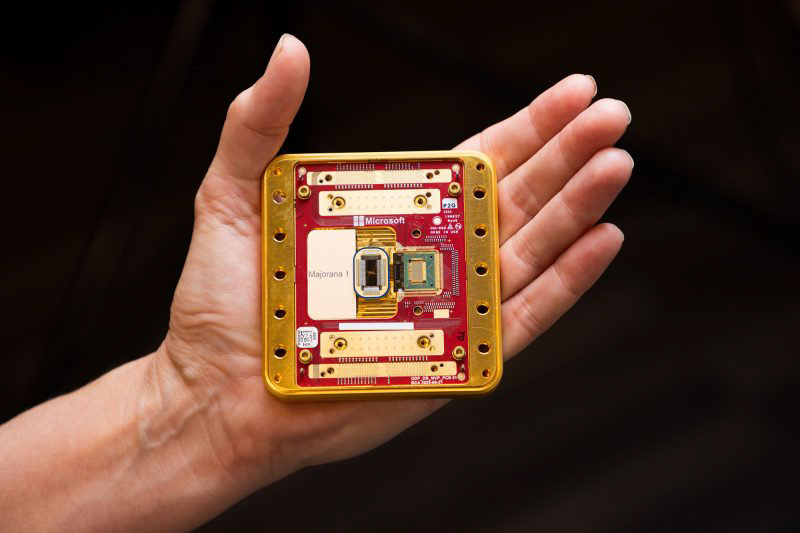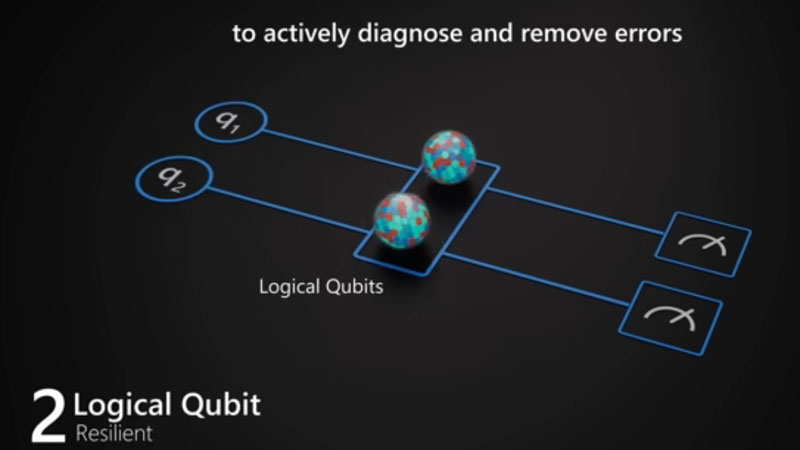There is an opinion among experts that the new topological quantum processor Microsoft Majorana 1 on hypothetical Majorana fermions is akin to the essence of quantum physics, thanks to which the famous Schrödinger’s cat is both dead and alive at the same time. Majorana fermions exist only in theory for now, which did not stop the company from announcing the creation of a processor on yet undiscovered particles. There are no particles, but there is a processor. Fantastic!

Image source: Microsoft
Let us recall that this week Microsoft presented the quantum processor Majorana 1. The solution is called revolutionary, because it is the first in the world to be based on a topological material. Topological materials are distinguished by the fact that the charge is located on their surface and does not penetrate deep. This gives them a number of interesting properties, including the highest noise immunity.
According to Microsoft, the Majorana 1 processor is 800 times more resistant to interference (errors) than competing developments. Thus, the company hints that it is ready to create a quantum computer free of errors in the foreseeable future. In other words, quantum computers will become practically significant with all the ensuing consequences – cracking the most secure codes today, breakthroughs in materials science, pharmacology and in general in all spheres of human life and activity.
Despite the loud statements, experts are skeptical about Microsoft’s statements. The company has not publicly provided any evidence of qubits working on Majorana fermions, and therefore the work of the Majorana 1 processor and the platform as a whole is also not supported by any evidence. For this, the company has been criticized.
«”If you have any new results that are not related to this paper, why don’t you wait until you have enough material for a separate publication?” says Daniel Loss, a physicist at the University of Basel, Switzerland. “Without seeing additional data on the qubit, we can’t comment much,” says Georgios Katsaros, a physicist at the Austrian Institute of Science and Technology in Klosterneuburg.
Microsoft has found a way to respond to criticism of the early publication of the “results.” “We strive to publish our research results in a timely and open manner, as well as to protect the company’s intellectual property,” the company explains. Moreover, if we are to believe Microsoft, the research results were shown to a select group of physicists who found them interesting and promising.
«”Would I bet my life that they see what they think? No, but it looks pretty good,” said Steven Simon, a theoretical physicist at the University of Oxford, UK, who was briefed on the results. “There is no definitive proof that qubits are made up of topological states right away.” That would be proven definitively if they worked as expected after scaling up the device, he added.
«”We created a qubit and showed that you can not only measure the parity in two parallel wires, but you can also make a measurement connecting the two wires,” the Microsoft researcher says in his defense.
«As we make more types of measurements, it becomes increasingly difficult to explain our results using non-topological models, the company says. “We may never convince everyone of this. But non-topological explanations will require more and more fine-tuning.” In other words, all the processes demonstrated will point to Microsoft being right and critics being wrong.
A little more has also become known about the “Majorana qubit.” Majorana fermions are hypothetical particles, and some of their characteristics can be reproduced in the collective states of electrons or other elementary particles. In this case, they would be quasiparticles. The qubit created at Microsoft is two indium arsenide nanowires connected by a jumper in the middle, depicting a large Latin letter H.

Majorana quasiparticles in the form of groups of electrons are collected at the ends of the H-structure. In all cases, they consist of Cooper pairs of electrons, which are “paired” by the phenomenon of superconductivity, and the Microsoft qubit is superconducting. Then, one single electron, which has no pair, is introduced into each of the two nanowires. The introduction of an additional, unpaired electron creates an excited state. This electron in each nanowire exists in a “delocalized” state (its wave function is smeared over the two wave functions of the Majorana quasiparticles at the ends of the wire). All this supposedly allows the qubit to be in a state of superposition.
The original Microsoft paper cites measurements showing that the nanowire does indeed contain an extra electron. These tests “by themselves” do not guarantee that the nanowire contains two Majorana quasiparticles, the authors caution, but they are very hopeful.
Let us add that back in 2018, scientists from the Netherlands, using Microsoft’s money, conducted an experiment, based on which they published an article on the creation of Majorana quasiparticles. The article was later retracted from the journal Nature, where it was published. One of the critics of the article, who contributed to its retraction, Vincent Mourik, a physicist from the Helmholtz Research Center in Jülich, Germany, is sure: “At a fundamental level, the approach to creating a quantum computer based on Majorana topological qubits in the form in which it is proposed by Microsoft will not work.” The king, apparently, turned out to be naked, as in the fairy tale of the same name.